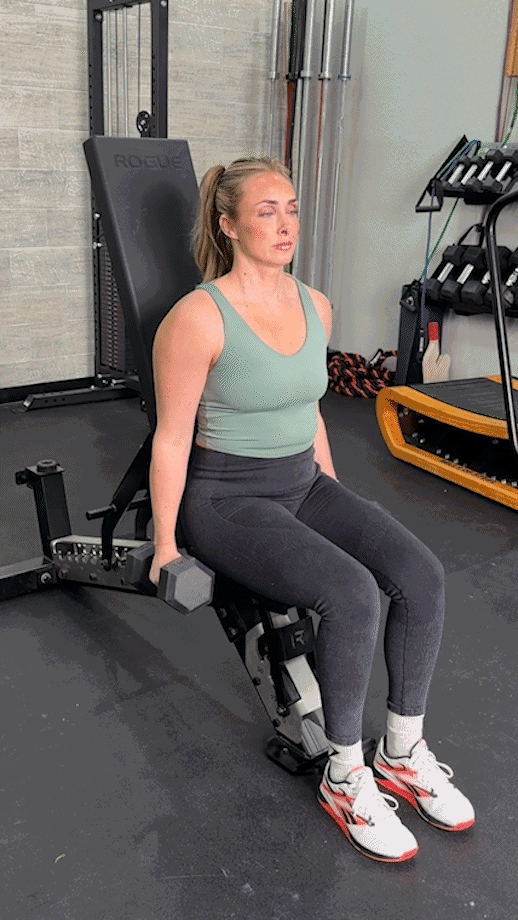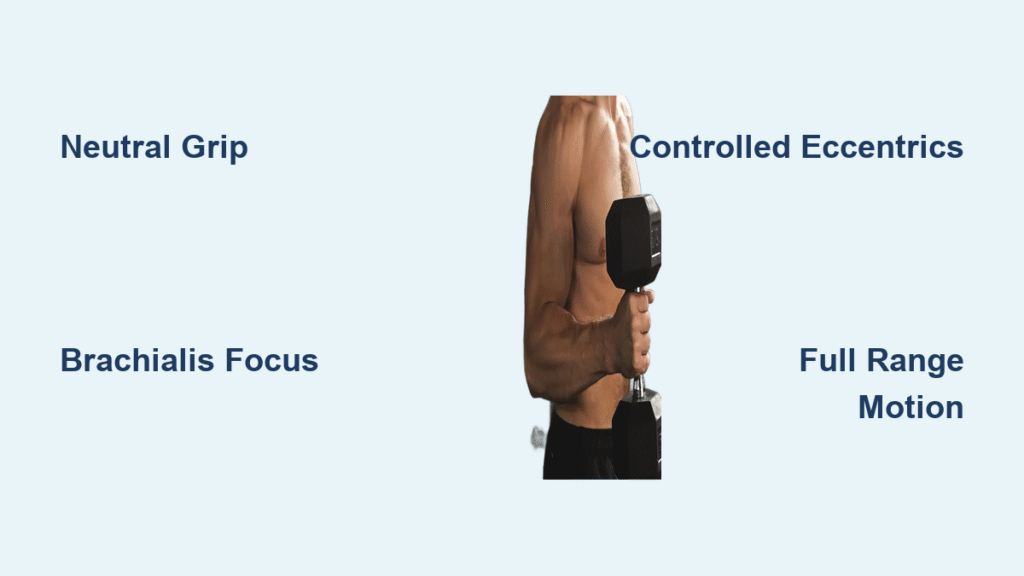Your biceps feel stubbornly flat despite endless traditional curls. That gap between your biceps and forearms won’t fill out, no matter how many reps you grind through. You’re missing the secret weapon: dumbbell hammer bicep curls. This neutral-grip powerhouse uniquely targets both upper arms and forearms in one fluid motion, building the 3D arm development most lifters chase for years. Forget isolated bicep work—this exercise delivers complete arm transformation by engaging four critical muscles simultaneously. In the next few minutes, you’ll learn the exact technique, programming hacks, and mistake-proofing strategies to add real mass where it matters most.
Most lifters waste energy on curls that only hit half the equation. Dumbbell hammer bicep curls fix this by activating the brachialis—the hidden muscle beneath your biceps that pushes your peak upward. When this muscle grows, your biceps visually expand even without direct work. Pair this with the brachioradialis forearm activation from the neutral grip, and you’ve got the ultimate arm-building trifecta: thickness, height, and definition. Skip this movement, and you’re leaving your full arm potential on the table.
Why Your Neutral Grip Builds Complete Arms
Dumbbell hammer bicep curls trigger unique muscle recruitment impossible with standard curls. The palms-facing grip shifts emphasis to the brachialis—a powerhouse muscle running under your biceps. As this muscle thickens, it literally lifts your biceps into a more dramatic peak. Simultaneously, the brachioradialis in your forearm fires intensely, creating that coveted “forearm shelf” where biceps meet elbow. Traditional supinated curls miss 40% of this growth potential by neglecting these critical muscles.
This exercise uniquely balances biceps and forearm development. The neutral grip reduces bicep brachii dominance, allowing the brachialis to contribute maximally. Result? Arms that look powerful from every angle—not just when flexing palms-up. Most lifters discover their forearms grow faster than biceps with consistent hammer curl work, proving the movement’s comprehensive impact.
Equipment Selection Criteria
Grab dumbbells challenging for your target rep range without forcing momentum. If you can’t pause for two seconds at the top position, the weight’s too heavy. Beginners should start with 5-10 pound dumbbells to master mechanics before progressing. Always prioritize control—muscle tension trumps ego lifting. Test weights by performing five slow reps: if your elbows drift forward or wrists collapse, reduce the load immediately.
Body Alignment Essentials
Plant feet shoulder-width apart with soft knees to create a stable base. Squeeze shoulder blades together as if pinching a pencil between them—this prevents shoulder shrugging. Engage your core by bracing as if anticipating a light punch to the stomach. Maintain a neutral spine throughout; leaning backward recruits back muscles and sabotages arm isolation. Any movement in your torso means the weight’s too heavy.
Grip and Arm Position
Hold dumbbells like actual hammers—palms facing your thighs, thumbs wrapped securely around the handles. Let arms hang naturally at your sides with elbows tucked against your ribs. This neutral grip must stay locked from start to finish; rotating palms even slightly reduces brachialis activation. Your forearms should remain perpendicular to the floor during the entire movement—no tilting forward or backward.
Execute Dumbbell Hammer Curls Like a Pro

Controlled Lifting Phase
Initiate each rep by bending elbows 10-15 degrees to establish tension—never jerk the weights upward. Curl both dumbbells simultaneously along a slight arc toward your chest pockets, not straight up. Move deliberately: a 1-2 second lift ensures constant muscle tension. Your elbows must stay glued to your torso; if they drift forward, you’re using momentum instead of biceps. Watch for shoulder involvement—your traps shouldn’t rise toward your ears.
Peak Contraction Hold
Stop when dumbbells reach lower chest level (or maximum comfortable height). Squeeze biceps and forearms intensely for 1-2 seconds—this isometric pause triggers maximum fiber recruitment. You should feel a burning “pump” across the entire front of your upper arm and down into the forearm. Avoid lifting higher by leaning back; this shifts tension to your shoulders. If you lose the squeeze, reduce weight immediately.
Eccentric Lowering Control
Lower weights with strict 2-3 second control—this phase causes 60% of muscle growth. Actively resist gravity rather than dropping the dumbbells; imagine placing them gently on a shelf. Never fully lock elbows at the bottom; maintain slight flexion to keep muscles engaged. Rushing the descent wastes growth potential and strains elbow tendons. Master this tempo before adding weight.
Breathing Pattern
Exhale forcefully as you lift—this stabilizes your core and increases intra-abdominal pressure. Inhale deeply while lowering to oxygenate working muscles. Never hold your breath; proper breathing prevents blood pressure spikes and maintains rep consistency. Time your exhale to match peak contraction for maximum neural drive.
Program Dumbbell Hammer Curls for Your Specific Goal

Strength Building Protocol
Use 3-4 sets of 4-6 reps with challenging weights (75-85% of your 1RM). Rest 2-3 minutes between sets to fully replenish phosphocreatine stores. Add 2.5-5 pounds only when you complete all sets with perfect form. Test new weights on seated variations first—this eliminates momentum and verifies true strength gains.
Hypertrophy Maximization
Perform 3-4 sets of 8-12 reps with moderate loads (65-75% of 1RM). Keep rest periods to 60-90 seconds to maximize metabolic stress. Focus on the 1-2 second peak contraction—this time under tension triggers sarcoplasmic hypertrophy. Pair with traditional curls in the same workout for complete biceps development.
Endurance and Toning
Complete 2-3 sets of 15-20 reps with light dumbbells (50-60% of 1RM). Rest just 30-45 seconds to build capillary density. This high-rep approach enhances muscle definition without bulk, ideal for athletic aesthetics. Use slow eccentrics (3-4 seconds down) to increase time under tension.
Stop These 5 Dumbbell Hammer Curl Mistakes Now
Elbow Drift: Letting elbows swing forward disengages brachialis. Fix: Pin elbows against your ribs throughout—imagine holding a credit card between elbow and torso.
Wrist Breakdown: Bending wrists inward or outward shifts stress to tendons. Fix: Keep wrists rigid and neutral—your knuckles should stay parallel to the floor.
Momentum Cheating: Swinging weights recruits shoulders. Fix: Reduce weight until you can perform 8 strict reps with zero torso movement.
Half Reps: Cutting range limits growth. Fix: Lower until arms are nearly straight (but not locked), lift until forearms touch biceps.
Weight Ego: Using excessive load. Fix: If you can’t pause at the top, drop 20% and rebuild form—muscle growth follows tension quality, not weight numbers.
Advanced Dumbbell Hammer Curl Variations That Deliver

Seated Isolation Method
Sit upright on a bench with back support to eliminate body sway. This strict version exposes weak links—expect to use 15-20% less weight. The fixed position forces relentless tension on brachialis, making it ideal for hypertrophy phases.
Incline Long-Head Emphasis
Set bench to 45-60 degrees and let arms hang straight down. This stretch-position maximizes long head activation for bicep peak development. Warning: You’ll need 10-15% lighter weights than standing versions due to reduced mechanical advantage.
Cross-Body Peak Activation
Alternate arms while bringing each dumbbell toward the opposite pec. This subtle angle increases brachialis engagement by 30% compared to standard hammer curls. Stop when forearm touches chest—no twisting at the shoulder.
Cable Constant Tension
Use rope attachments on low cables with palms facing inward. The horizontal pull provides unyielding resistance through the entire range, especially during the critical lowering phase. Ideal for metabolic training sets.
Prevent Injuries While Maximizing Gains
Essential Warm-Up Sequence
Start with 5 minutes of rowing or cycling to increase blood flow. Perform 10 arm circles forward/backward and 15 wrist rotations. Complete two warm-up sets: first with 50% working weight for 15 reps, then 70% for 10 reps. Never skip this—cold elbow tendons are injury magnets.
Red Flags to Stop Immediately
Sharp elbow or wrist pain means halt the set. Dull muscle burn is normal; joint pain is not. If discomfort persists after 24 hours, consult a physical therapist—especially if you have pre-existing tendonitis. Never “push through” elbow pain; it compounds microtears.
Progressive Overload Guidelines
Increase weight by 2.5-5 pounds only after hitting the top of your rep range for all sets with perfect form. Track every workout—consistent 2.5-pound jumps every 2-3 weeks build sustainable strength. When stuck, add reps before adding weight: 12→15 reps precedes 2.5-pound increase.
Integrate Dumbbell Hammer Curls Into Your Weekly Plan
Beginners: Perform hammer curls twice weekly (e.g., Monday pull/Thursday arms) with 72 hours between sessions. Start with two sets of 10-12 reps using light dumbbells. Intermediate lifters: Program three weekly sessions—pair with heavy rows on pull day, superset with concentration curls on arm day, and finish with high-rep sets on metabolic conditioning days. Advanced trainees: Use periodization—4 weeks of strength (4-6 reps), 4 weeks of hypertrophy (8-12 reps), then 2 weeks of active recovery (15-20 reps).
Mastering dumbbell hammer bicep curls transforms arms from flat to formidable by building what traditional curls miss. Commit to perfect form for just four weeks—use controlled eccentrics, hit full range of motion, and prioritize the peak contraction—and you’ll see thickness develop across your entire upper arm. Track your weights religiously, celebrate small jumps, and remember: consistent perfect reps build arms that turn heads, not sporadic ego lifts. Your complete arm development journey starts with the next set—grab those dumbbells and hammer your way to 3D arms today.




